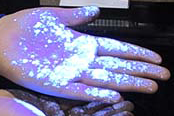Good Hand Washing? Turn on the Black Light!

"Glowing" germs let students test their hand washing techniques, evaluate areas of the hand, and investigate germ transmission! Image source: Glo Germ, used with permission.
With its emphasis on creepy, crawly, nighttime fun, Halloween is a perfect time for things that glow, from the flickering lights inside carved pumpkins to neon sticks. Last week, we took a look at the chemical reaction that happens when you snap open a glow stick—and a great chemistry project that lets students put their electronics-knowhow to use to measure the power of a glow stick's chemiluminescence.
'Glow' can be fun, but 'glow' can also be used to detect things otherwise invisible to the naked eye. Many things glow under a black or ultraviolet light, and casting a black light around a crime scene is a familiar part of a forensics investigation. A black light and a specially formulated hand "lotion" can even help students better visualize the lasting power of germs!
Healthy Hands
As the pumpkins on the stoop cave in and find their way to compost, the shifting seasons—and the 'flu shot' banners hanging in many pharmacies—bring winter colds to mind. Good hand washing is always important, and you can catch a cold at any time—not only in fall and winter months. But with Halloween over, a heightened awareness of "flu season" kicks into gear.
You may have heard that you should wash your hands for a full twenty seconds—a length of time you can approximate by singing "Happy Birthday" twice. If you wash for twenty seconds, odds are that you'll have gotten most of the germs. Right?
It depends. Are some areas of the hand harder to clean than others?
Putting It to the Test
In the Spread the Soap, Not the Germs microbiology project, students can investigate hand washing and explore questions related to length of time, parts of the hand, and even temperature of the water used for washing. Using Glo Germ, students add glow-ready germs to their hands and then wash them. After washing hands, they can use an ultraviolet light to see whether they "got" all the germs or not.
If germs always glowed, healthy hand washing habits might be a lot easier to instill!
Taking It Further
If you're interested in exploring germs—either the spread of germs or efforts to get rid of germs—you can find many ways to customize or alter the Spread the Soap, Not the Germs project. Do you use a no-wash antibacterial hand sanitizer? Put it to the Glo Germ test! Or, take a completely different approach and explore the way germs travel during typical school interactions. Get the germ train rolling by planting some Glo Germ either in a central (or much-touched) location or on someone's hands. How many students in a class will pick up the germs by the end of the day?
Wath the Glo Germ Dragonfly video with this project to see how Jordan and Sydney put Glo Germ to the test to investigate the spread of germs—and the best way to prevent germs from spreading when you sneeze!
Categories:
You Might Also Enjoy These Related Posts:
- Plastics and Earth Day - Science Projects
- Arduino Science Projects and Physical Computing
- 10+ Robotics Projects with the BlueBot Kit
- 5 STEM Activities with Marshmallow Peeps
- March Madness Basketball Science Projects: Sports Science Experiments
- Women in STEM! More than 60 Scientists and Engineers for Women's History Month
- Explore Artificial Intelligence and Machine Learning with Student AI Projects
- 10 Reasons to Do the Rubber Band Car Engineering Challenge









